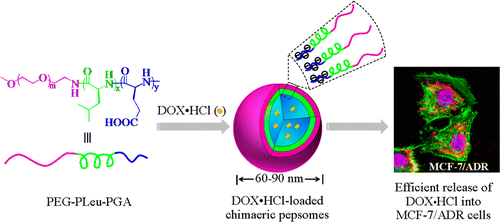Biomedical Polymers Laboratory, and Jiangsu Key Laboratory of Advanced Functional Polymer Design and Application, College of Chemistry, Chemical Engineering and Materials Science, Soochow University, Suzhou, 215123, People's Republic of China
Biomacromolecules 2015, 16, 1322–1330
pH-Responsive chimaeric polypeptide-based polymersomes (refer to as pepsomes) were designed and developed from asymmetric poly(ethylene glycol)-b-poly(l-leucine)-b-poly(l-glutamic acid) (PEG-PLeu-PGA, PEG is longer than PGA) triblock copolymers for efficient encapsulation and triggered intracellular delivery of doxorubicin hydrochloride (DOX·HCl). PEG-PLeu-PGA was conveniently prepared by sequential ring-opening polymerization of l-leucine N-carboxyanhydride and γ-benzyl-l-glutamate N-carboxyanhydride using PEG-NH2 as an initiator followed by deprotection. Pepsomes formed from PEG-PLeu-PGA had unimodal distribution and small sizes of 64–71 nm depending on PLeu block lengths. Interestingly, these chimaeric pepsomes while stable at pH 7.4 were quickly disrupted at pH 5.0, likely due to alternation of ionization state of the carboxylic groups in PGA that shifts PGA blocks from hydrophilic and random coil structure into hydrophobic and α-helical structure. DOX·HCl could be actively loaded into the watery core of pepsomes with a high loading efficiency. Remarkably, the in vitro release studies revealed that release of DOX·HCl was highly dependent on pH, in which about 24.0% and 75.7% of drug was released at pH 7.4 and 5.0, respectively, at 37 °C in 24 h. MTT assays demonstrated that DOX·HCl-loaded pepsomes exhibited high antitumor activity, similar to free DOX·HCl in RAW 264.7 cells. Moreover, they were also potent toward drug-resistant MCF-7 cancer cells (MCF-7/ADR). Confocal microscopy studies showed that DOX·HCl-loaded pepsomes delivered and released drug into the cell nuclei of MCF-7/ADR cells in 4 h, while little DOX·HCl fluorescence was observed in MCF-7/ADR cells treated with free drug under otherwise the same conditions. These chimaeric pepsomes with facile synthesis, efficient drug loading, and pH-triggered drug release behavior are an attractive alternative to liposomes for targeted cancer chemotherapy.

链接:
//pubs.acs.org/doi/abs/10.1021/acs.biomac.5b00113